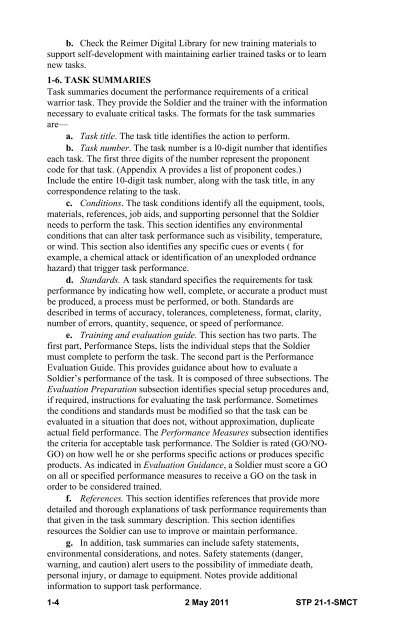Warrior Skills Level 1 - Leader Development for Army Professionals
Warrior Skills Level 1 - Leader Development for Army Professionals
Warrior Skills Level 1 - Leader Development for Army Professionals
Create successful ePaper yourself
Turn your PDF publications into a flip-book with our unique Google optimized e-Paper software.
. Check the Reimer Digital Library <strong>for</strong> new training materials to<br />
support self-development with maintaining earlier trained tasks or to learn<br />
new tasks.<br />
1-6. TASK SUMMARIES<br />
Task summaries document the per<strong>for</strong>mance requirements of a critical<br />
warrior task. They provide the Soldier and the trainer with the in<strong>for</strong>mation<br />
necessary to evaluate critical tasks. The <strong>for</strong>mats <strong>for</strong> the task summaries<br />
are—<br />
a. Task title. The task title identifies the action to per<strong>for</strong>m.<br />
b. Task number. The task number is a l0-digit number that identifies<br />
each task. The first three digits of the number represent the proponent<br />
code <strong>for</strong> that task. (Appendix A provides a list of proponent codes.)<br />
Include the entire 10-digit task number, along with the task title, in any<br />
correspondence relating to the task.<br />
c. Conditions. The task conditions identify all the equipment, tools,<br />
materials, references, job aids, and supporting personnel that the Soldier<br />
needs to per<strong>for</strong>m the task. This section identifies any environmental<br />
conditions that can alter task per<strong>for</strong>mance such as visibility, temperature,<br />
or wind. This section also identifies any specific cues or events ( <strong>for</strong><br />
example, a chemical attack or identification of an unexploded ordnance<br />
hazard) that trigger task per<strong>for</strong>mance.<br />
d. Standards. A task standard specifies the requirements <strong>for</strong> task<br />
per<strong>for</strong>mance by indicating how well, complete, or accurate a product must<br />
be produced, a process must be per<strong>for</strong>med, or both. Standards are<br />
described in terms of accuracy, tolerances, completeness, <strong>for</strong>mat, clarity,<br />
number of errors, quantity, sequence, or speed of per<strong>for</strong>mance.<br />
e. Training and evaluation guide. This section has two parts. The<br />
first part, Per<strong>for</strong>mance Steps, lists the individual steps that the Soldier<br />
must complete to per<strong>for</strong>m the task. The second part is the Per<strong>for</strong>mance<br />
Evaluation Guide. This provides guidance about how to evaluate a<br />
Soldier’s per<strong>for</strong>mance of the task. It is composed of three subsections. The<br />
Evaluation Preparation subsection identifies special setup procedures and,<br />
if required, instructions <strong>for</strong> evaluating the task per<strong>for</strong>mance. Sometimes<br />
the conditions and standards must be modified so that the task can be<br />
evaluated in a situation that does not, without approximation, duplicate<br />
actual field per<strong>for</strong>mance. The Per<strong>for</strong>mance Measures subsection identifies<br />
the criteria <strong>for</strong> acceptable task per<strong>for</strong>mance. The Soldier is rated (GO/NO-<br />
GO) on how well he or she per<strong>for</strong>ms specific actions or produces specific<br />
products. As indicated in Evaluation Guidance, a Soldier must score a GO<br />
on all or specified per<strong>for</strong>mance measures to receive a GO on the task in<br />
order to be considered trained.<br />
f. References. This section identifies references that provide more<br />
detailed and thorough explanations of task per<strong>for</strong>mance requirements than<br />
that given in the task summary description. This section identifies<br />
resources the Soldier can use to improve or maintain per<strong>for</strong>mance.<br />
g. In addition, task summaries can include safety statements,<br />
environmental considerations, and notes. Safety statements (danger,<br />
warning, and caution) alert users to the possibility of immediate death,<br />
personal injury, or damage to equipment. Notes provide additional<br />
in<strong>for</strong>mation to support task per<strong>for</strong>mance.<br />
1-4 2 May 2011 STP 21-1-SMCT

















